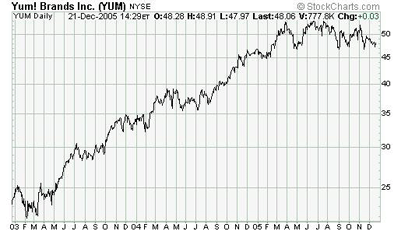| Home | About Us | Resources | Archive | Free Reports | Market Window |
The Final Clue in A Giant Crossword PuzzleBy
Thursday, December 22, 2005
The gold action of the last few weeks has given me major cause for thought. I haven’t slept a wink. I can’t concentrate on anything. Sometime I feel smoke coming out of my ears. It’s as if I can’t solve the final clue in a giant crossword puzzle. Here’s the puzzle: In 2001, after 20 years of ridicule and mockery, gold finally ended its bear market and started rising. Between 2001 and 2005, it marched... in a beautiful up-trend... without the slightest sign of panic or exuberance, from $235 to $475. Then came the fireworks. Gold surged from $500 to $540 in eight trading days and then collapsed back to $490 in another three. One commentator called it, “The most spectacular move in precious metal prices since the Hunt brothers tried to corner the silver market.” What I really want to know is: Where do we go from here? One of the most important concepts in investing is... consensus. When everyone is thinking the same way, the trend is at its end. The bets are placed. The idea is fully reflected in the price and there’s no money left to push the trend further. At this point, the market can only go down. Look at the oil market in August 2005 as an example. Consensus for higher prices was so strong – everyone was talking about the oil running out and how demand could only grow – that even an event like Hurricane Katrina, one of the most bullish scenarios possible for oil, couldn’t keep prices up. Actually, the reasons don’t matter. Everyone was committed to a further rise in oil prices, so the next move had to be down. And so I scan the media every day to gauge mainstream opinion. At the moment, no one seems to agree on the reasons for gold’s rise. I like that. Both the experts and the press are confused. There’s little consensus. It signals this bull market has room to run. Check out this indecision: -The Financial Times says it’s the Japanese. Gold is the hedge of choice for Japanese investors faced with a falling currency, they wrote. -BCA Research says gold is being driven by excess global liquidity and a lack of conviction in the major currencies. Other articles pointed at the central banks. South Africa and Argentina are stocking up their vaults with gold, they said. I don’t care about the particular reasons – they distract me and, to be honest, they make my head spin. The point is, when you get near the top of a bubble, you expect to find consensus. The media uses 7-second sound bites to explain the move. Suckers are drawn in by the idea’s simplicity. Take gold’s super-spike in the late 70s. That bubble is still summed up in one word... inflation. In conclusion, until the reasons for gold’s bull market are easy to understand, and investors form a consensus opinion, gold will not stop rising. Good Investing, Tom Dyson Market NotesA BULL MARKET IN GLUTTONY
|
As mentioned in yesterday’s PRIVY, the U.S. surgeon general calls America’s obesity problem “ every bit as threatening to us as is the terrorist threat we face today .” Here in the land of the free, 64% of U.S. adults are overweight or obese, as reported by the American Obesity Association. The problem is getting worse as America gets richer. So why not make some money off the fun? That’s exactly what the outstanding mutual fund Longleaf Partners is doing these days. Considered one of the best value-driven investors on the planet, portfolio manager Mason Hawkins has 5.4% of the Longleaf Partners Fund (LLPFX) invested in Yum! Brands (YUM), the operator of Taco Bell, Pizza Hunt, and KFC. A look at how the bull market in gluttony has helped YUM in the past 3 years:
|
Recent Articles
|


